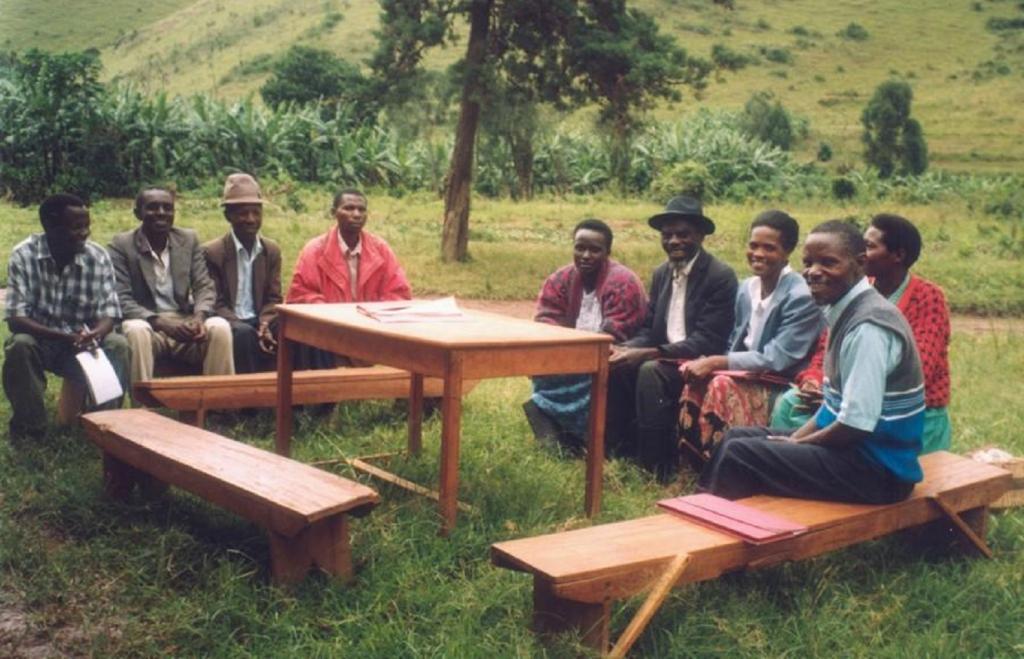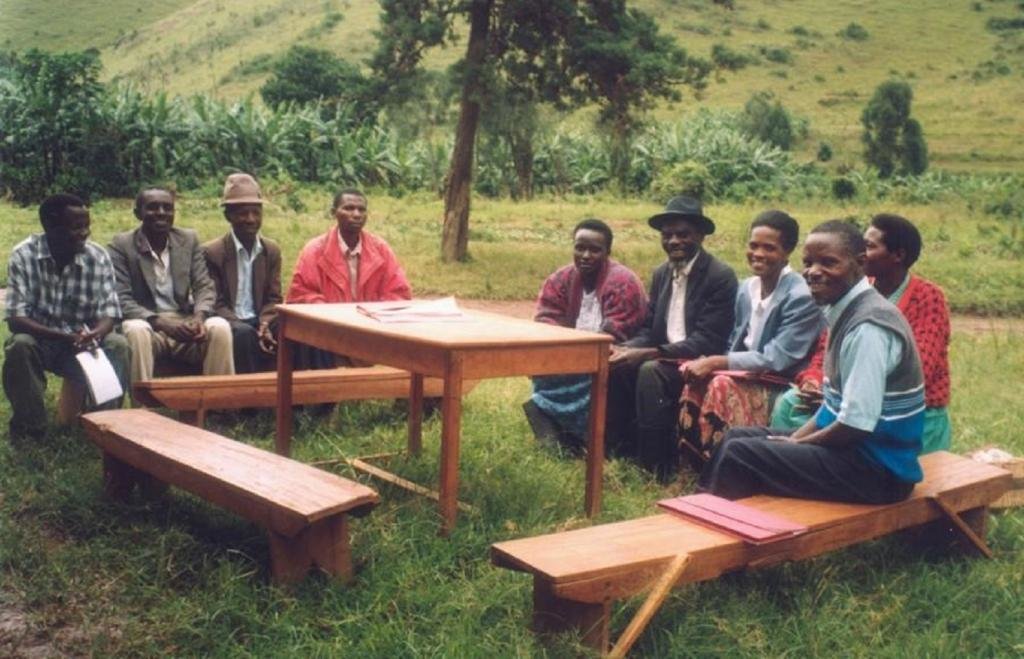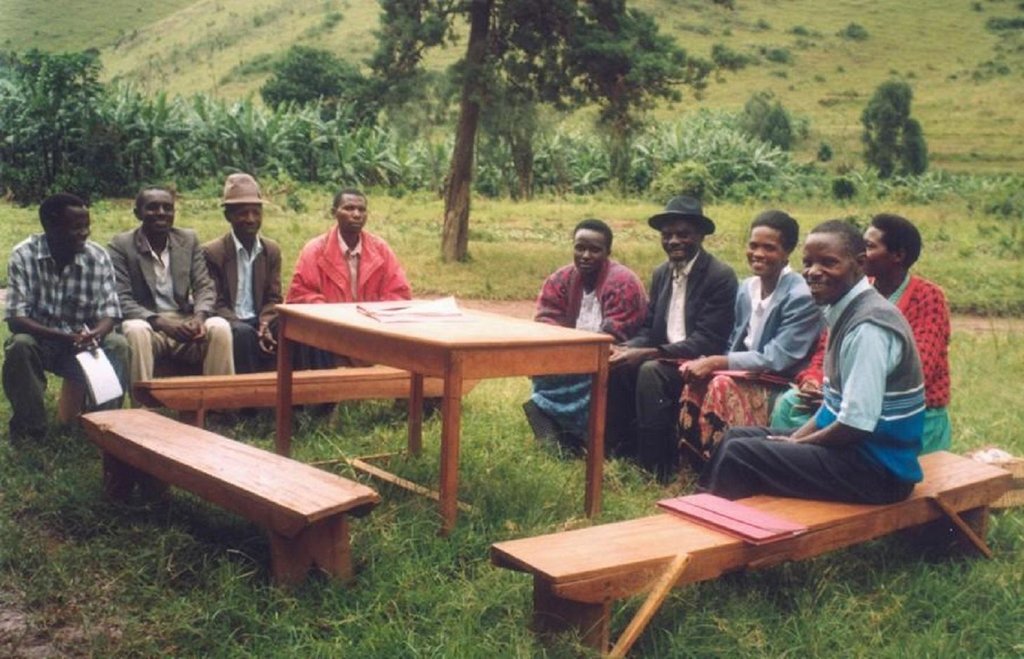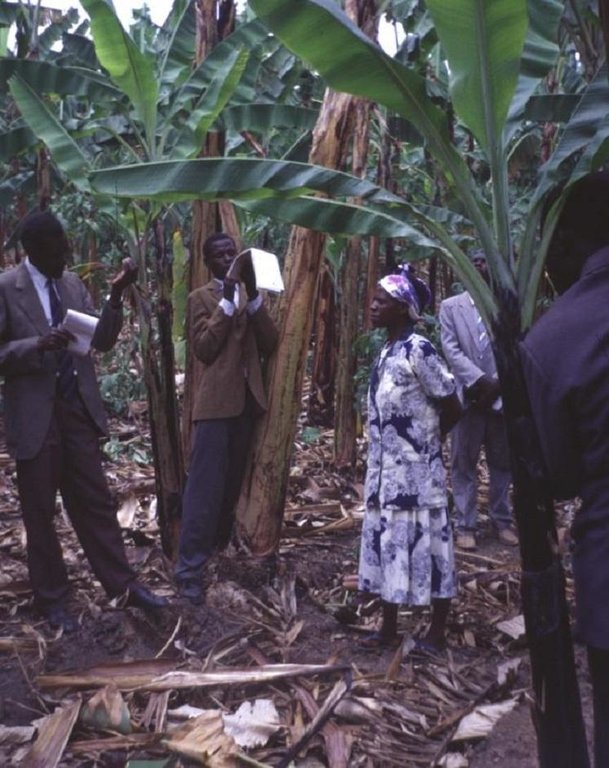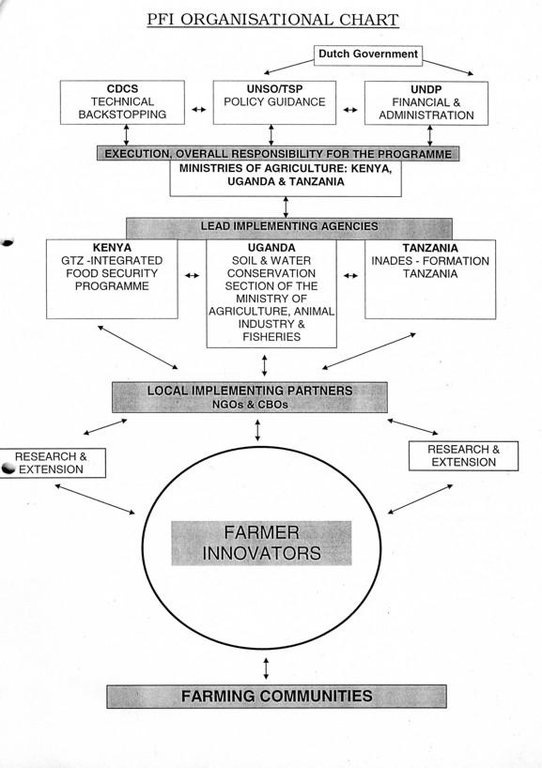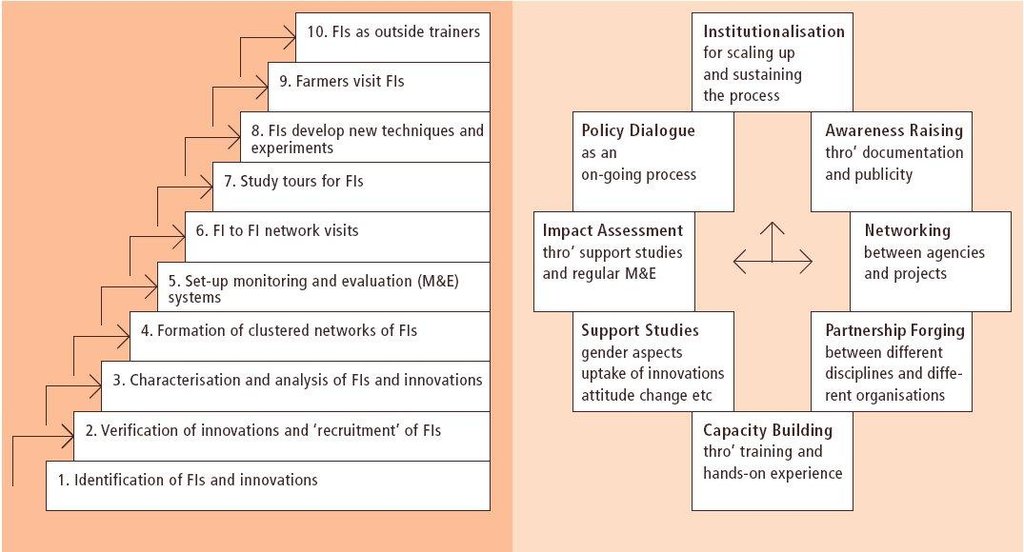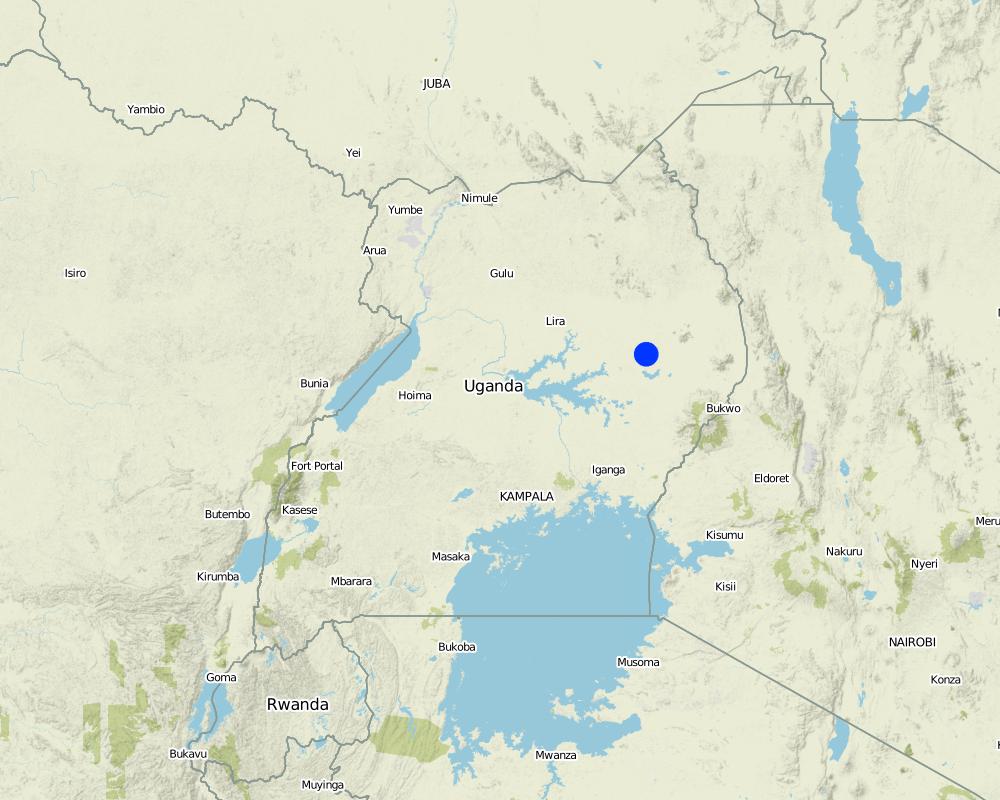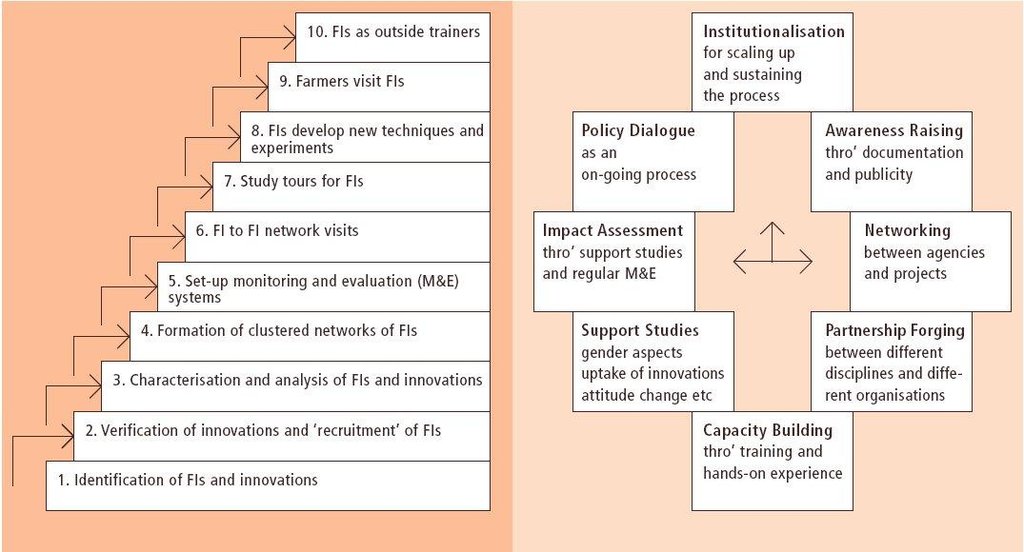Promoting farmer innovation [ອູເຈນດາ]
- ການສ້າງ:
- ປັບປູງ:
- ຜູ້ສັງລວມຂໍ້ມູນ: Kithinji Mutunga
- ບັນນາທິການ: –
- ຜູ້ທົບທວນຄືນ: Fabian Ottiger
approaches_2418 - ອູເຈນດາ
ເບິ່ງພາກສ່ວນ
ຂະຫຍາຍທັງໝົດ ຍຸບທັງໝົດ1. ຂໍ້ມູນທົ່ວໄປ
1.2 ລາຍລະອຽດ ການຕິດຕໍ່ ຂອງບຸກຄົນທີ່ຊັບພະຍາກອນ ແລະ ສະຖາບັນ ການມີສ່ວນຮ່ວມ ໃນການປະເມີນຜົນ ແລະ ເອກະສານ ຂອງວິທີທາງ
ຜູ້ຊ່ຽວຊານ ດ້ານການຄຸ້ມຄອງ ທີ່ດິນແບບຍືນຍົງ:
ຊື່ຂອງ ສະຖາບັນການຈັດຕັ້ງ ທີ່ອໍານວຍຄວາມສະດວກ ໃນການສ້າງເອກກະສານ ຫຼື ປະເມີນແນວທາງ (ຖ້າກ່ຽວຂ້ອງ)
FAO Food and Agriculture Organization (FAO Food and Agriculture Organization) - ອີຕາລີຊື່ຂອງ ສະຖາບັນການຈັດຕັ້ງ ທີ່ອໍານວຍຄວາມສະດວກ ໃນການສ້າງເອກກະສານ ຫຼື ປະເມີນແນວທາງ (ຖ້າກ່ຽວຂ້ອງ)
CIS-Centre for International Cooperation (CIS-Centre for International Cooperation) - ເນເທີແລນຊື່ຂອງ ສະຖາບັນການຈັດຕັ້ງ ທີ່ອໍານວຍຄວາມສະດວກ ໃນການສ້າງເອກກະສານ ຫຼື ປະເມີນແນວທາງ (ຖ້າກ່ຽວຂ້ອງ)
Ministry of Agriculture, Livestock and Fisheries (MoA) - ເຄັນຢາ1.3 ເງື່ອນໄຂ ຂອງການນໍາໃຊ້ເອກກະສານຂໍ້ມູນ ຂອງ WOCAT
ຜູ້ສັງລວມ ແລະ ບັນດາຜູ້ຕອບແບບສອບຖາມ ຍອມຮັບໃນເງື່ອນໄຂ ການນໍາໃຊ້ຂໍ້ມູນເອກະສານ ທີ່ສ້າງຂື້ນ ໂດຍຜ່ານ ອົງການ WOCAT:
ແມ່ນ
1.4 ເອກະສານອ້າງອີງ (ຫຼາຍ) ກັບແບບສອບຖາມ (ຫຼາຍ) ເຕັກໂນໂລຢີ ຂອງດ້ານການຄຸ້ມຄອງ ດິນແບບຍືນຍົງ
2. ພັນລະນາ ແນວທາງການຄຸ້ມຄອງນໍາໃຊ້ດິນແບບຍືນຍົງ
2.1 ການອະທິບາຍ ໂດຍຫຍໍ້ ຂອງວິທີທາງ
Identification of farmer innovators in SWC and water harvesting, and using them as focal points for visits from other farmers to spread the practices and stimulate the process of innovation.
2.2 ການອະທິບາຍ ລາຍລະອຽດ ຂອງວິທີທາງ
ການອະທິບາຍ ລາຍລະອຽດ ຂອງວິທີທາງ:
Aims / objectives: The Promoting Farmer Innovation (PFI) approach seeks to build on technical initiatives - innovations in the local context - developed by farmers themselves in dry/marginal areas where the conventional approach of transfer of technology from research to extension agents, and then on to farmers, has so often failed. The approach basically comprises identifying, validating and documenting local innovations/initiatives. Simple monitoring and evaluation systems are set up amongst those innovative farmers who are willing to co-operate. Through contact with researchers, extra value is added to these techniques where possible. Farmer innovators are brought together to share ideas. Finally, best-bet technologies, in other words those that are considered to be good enough to be shared, are disseminated through farmer-to-farmer extension. This takes two forms. First, farmers are brought to visit the innovators in their farms. Secondly farmer innovators are used as teachers/trainers to visit groups of farmers - including FAOs farmer field schools in some cases. Only in this second form of extension is an allowance payable to the innovator. A ten-step field activity methodology has been developed.
Methods: At programme level, there is capacity building of in-line extension and research staff, who are the main outside actors in the programme. In each of the countries the project has been implemented through a government ministry, which partners various NGOs in the field. The principle, and practice, is not to create separate project enclaves, but to work through existing personnel, sharing buildings and vehicles that are already operational in the area. A programme development process methodological framework shows how the ultimate goal of institutionalisation can be achieved. PFIs first phase, completed in 2000, was financed by the Government of The Netherlands, through UNDP, and was active in Kenya, Tanzania and Uganda.
2.3 ຮູບພາບຂອງແນວທາງ
2.5 ປະເທດ / ເຂດ / ສະຖານທີ່ບ່ອນທີ່ແນວທາງໄດ້ຖືກນໍາໃຊ້
ປະເທດ:
ອູເຈນດາ
ພາກພື້ນ / ລັດ / ແຂວງ:
East Africa (parts of Kenya, Tanzania and Uganda)
Map
×2.6 ວັນທີເລີ່ມຕົ້ນ ແລະ ສິ້ນສຸດ ການຈັດຕັ້ງປະຕີບັດ ວິທີທາງ
ສະແດງປີຂອງການເລີ່ມຕົ້ນ:
1996
ປີທີ່ສີ້ນສູດ (ຖ້າຢຸດບໍ່ໄດ້ນໍາໃຊ້ ວິທີທາງ):
2000
2.7 ປະເພດຂອງແນວທາງ
- ພາຍໃຕ້ໂຄງການ / ແຜນງານ
2.8 ເປົ້າໝາຍ / ຈຸດປະສົງຫຼັກ ຂອງການຈັດຕັ້ງປະຕິບັດ ວິທີທາງ
The Approach focused mainly on SLM with other activities (Better land husbandry practices (eg composting, crop selection))
Improve rural livelihoods through an increase in the rate of diffusion of appropriate SWC/water harvesting technologies based on farmer innovation, and through farmer-to-farmer exchange visits. At a higher level: to demonstrate the effectiveness of such an approach so that it can be institutionalised.
The SLM Approach addressed the following problems: - poor supply of relevant recommendations from research for small scale farmers in marginal areas - poor delivery of SWC technologies (where they exist) to farmers - lack of motivation of research and extension staff - isolation of promising ???innovative??? SWC/water harvesting ideas which address low crop yields, land degradation and poverty - lack of exchange of this knowledge
2.9 ເງື່ອນໄຂອໍານວຍ ຫຼື ຂັດຂວາງການປະຕິບັດຂອງເຕັກໂນໂລຢີ / ເຕັກໂນໂລຢີການນໍາໃຊ້ຕາມແນວທາງ
ສັງຄົມ / ວັດທະນະທໍາ / ມາດຕະຖານ ແລະ ຄຸນຄ່າທາງສາສະໜາ
- ເຊື່ອງຊ້ອນ
Favoured farmer syndrome: where too much attention is given to particular innovative farmers and jealousy is aroused in others
Treatment through the SLM Approach: Avoid working with innovators who are so exceptional that they are outside society and others cannot relate to them. Rotate the farmers who are used as learning points: in other words once another farmer has adopted the technology, use him or her as the focal point.
ມີຄວາມສາມາດ / ເຂັ້າເຖິງຊັບພະຍາກອນດ້ານການເງິນ ແລະ ການບໍລິການ
- ເຊື່ອງຊ້ອນ
Danger of identifying innovations that are good technically but too expensive for ordinary farmers to implement.
Treatment through the SLM Approach: Linked to point (1) above: beware of farmers who are too exceptional/too rich.
ການກໍ່ຕັ້ງສະຖາບັນ
- ເຊື່ອງຊ້ອນ
Lack of motivation of research and extension institutions
Treatment through the SLM Approach: Bringing them together with farmer innovatiors
ກ່ຽວກັບກົດໝາຍ (ສິດນໍາໃຊ້ດິນ, ສິດນໍາໃຊ້ນໍ້າ)
- ເຊື່ອງຊ້ອນ
Who gets the credit for the particular innovation?
Treatment through the SLM Approach: Important to make sure that an innovation is traced back within the locality to its roots, identifying the 'owner'. Especially important when a name is attached to an innovation.
The existing land ownership, land use rights / water rights hindered a little the approach implementation Farmers will only invest time and effort in innovation when they have secure land use rights (though not necessarily ownership), which is the case in all the areas where PFI has been operational. Access to land for women was a problem which inhibits women innovating.
ອື່ນໆ
- ເຊື່ອງຊ້ອນ
Cultural: Gender imbalance in identification of innovators: women overlooked
Treatment through the SLM Approach: Gender sensitisation and training: bring together the identifiers with the farmers - male and female.
3. ການມີສ່ວນຮ່ວມ ແລະ ບົດບາດຂອງພາກສ່ວນທີ່ກ່ຽວຂ້ອງທີ່ໄດ້ມີສ່ວນຮ່ວມ
3.1 ຜູ້ມີສ່ວນຮ່ວມ ໃນວິທີທາງ ແລະ ພາລະບົດບາດ ຂອງເຂົາເຈົ້າ
- ຜູ້ນໍາໃຊ້ດິນໃນທ້ອງຖິ່ນ / ຊຸມຊົນທ້ອງຖິ່ນ
- ຜູ້ຊ່ຽວຊານ ການນຄຸ້ມຄອງ ທີ່ດິນແບບຍືນຍົງ / ທີ່ປຶກສາດ້ານກະສິກໍາ
- ອົງການຈັດຕັ້ງ ທີ່ບໍ່ຂື້ນກັບລັດຖະບານ
All involved et different levels: after implementation mainly government and NGO
- ພະນັກງານຂັ້ນສູນກາງ (ຜູ້ວາງແຜນ, ຜູ້ສ້າງນະໂຍບາຍ)
All involved et different levels: after implementation mainly government and NGO
- ອົງການຈັດຕັ້ງ ສາກົນ
All involved et different levels: after implementation mainly government and NGO
ຖ້າຫາກມີຫຼາຍພາກສ່ວນທີ່ເຂົ້າຮ່ວມ ໃຫ້ລະບຸ ອົງການທີ່ເປັນຫຼັກ ໃນການຈັດຕັ້ງປະຕິບັດ:
International specialists in collaboration with/after discussions with national specialists and land users
3.2 ການມີສ່ວນຮ່ວມຂອງຜູ້ນໍາໃຊ້ທີ່ດິນໃນທ້ອງຖິ່ນ / ຊຸມຊົນທ້ອງຖິ່ນໃນໄລຍະທີ່ແຕກຕ່າງກັນຂອງແນວທາງ
| ການລວບລວມ ເອົາຜູ້ນໍາໃຊ້ດິນ ໃນທ້ອງຖິ່ນ / ຊຸມຊົນທ້ອງຖິ່ນ | ໃຫ້ລະບຸ ຜູ້ໃດທີ່ມີສ່ວນຮ່ວມ ໃນແຕ່ລະກິດຈະກໍາ? | |
|---|---|---|
| ການເລີ່ມຕົ້ນ / ແຮງຈູງໃຈ | ການບໍ່ປະຕິບັດ | public meetings, interviews/questionnaires, workshops/seminars, rapid/participatory rural appraisal; interviews/Participatory Rural Appraisals etc |
| ການວາງແຜນ | ການບໍ່ປະຕິບັດ | rapid/participatory rural appraisal, interviews/questionnaires, public meetings, workshops/seminars; interviews/Participatory Rural Appraisals etc |
| ການປະຕິບັດ | ການຮ່ວມມື | Mainly: farmer-to-farmer exchange, responsibility for minor steps; partly: responsibility for major steps; interviews/Participatory Rural Appraisals etc |
| ຕິດຕາມກວດກາ / ການປະເມີນຜົນ | ການຮ່ວມມື | Mainly: public meetings, measurements/observations; partly: workshop/seminars; monitoring, using forms designed mainly by specialists |
| Research | ການຮ່ວມມື | on-farm |
3.3 ແຜນວາດ (ຖ້າມີ)
ການອະທິບາຍ:
Farmer innovation methodology left: Field activities: the ten steps– from identification through to using innovators as trainers. (Critchley, 2000) right: Programme development processes: the framew
3.4 ການຕັດສິນໃຈກ່ຽວກັບການຄັດເລືອກເຕັກໂນໂລຢີຂອງການຄຸ້ມຄອງທີ່ດິນແບບຍືນຍົງ / ເຕັກໂນໂລຢີ
ລະບຸ ຄົນທີ່ຕັດສິນໃຈ ກ່ຽວກັບການຄັດເລືອກຂອງ ເຕັກໂນໂລຢີ / ເຕັກໂນໂລຢີ ຈະໄດ້ຮັບການປະຕິບັດ:
- ຜູ້ນໍາໃຊ້ທີ່ດິນຫຼັກ, ການສະໜັບສະໜູນ ໂດຍຜູ້ຊ່ຽວຊານ ການນໍາໃຊ້ທີ່ດິນແບບຍືນຍົງ
ອະທິບາຍ:
???Best -bet??? technologies chosen by extension agents/researchers based on the selection of innovative farmers??? technologies identified in the field - but the farmers choose (develop) which technology to implement.
Decisions on the method of implementing the SLM Technology were made by by land users* alone (self-initiative / bottom-up)
4. ການສະໜັບສະໜູນທາງດ້ານວິຊາການ, ການສ້າງຄວາມສາມາດ, ແລະ ການຈັດການຄວາມຮູ້.
4.1 ການສ້າງຄວາມສາມາດ / ການຝຶກອົບຮົມ
ຜູ້ນໍາໃຊ້ທີ່ດິນ ຫຼື ພາກສ່ວນກ່ຽວຂ້ອງອື່ນໆ ໄດ້ຮັບການຝຶກອົບຮົມບໍ່?
ແມ່ນ
ໃຫ້ລະບຸ ຜູ້ໃດທີ່ໄດ້ຮັບການຝຶກອົບຮົມ:
- ຜູ້ນໍາໃຊ້ດິນ
- SWC specialists, extensionists/trainers
ຮູບແບບຂອງການຝຶກອົບຮົມ:
- ກອງປະຊຸມ
- ຫຼັກສູດ
ຮູບແບບຂອງການຝຶກອົບຮົມ:
- farm visits
ໃນຫົວຂໍ້:
Staff seconded from Ministries of Agriculture/NGOs provide: (1) methodology training for participating staff (2) presentational skill training for farmer innovators and (3) training in gender aspects.
4.2 ການບໍລິການໃຫ້ຄໍາປຶກສາ
ເຮັດຜູ້ໃຊ້ທີ່ດິນມີການເຂົ້າເຖິງການບໍລິການໃຫ້ຄໍາປຶກສາ?
ແມ່ນ
ລະບຸວ່າການສະໜອງ ການບໍລິການ ໃຫ້ຄໍາປຶກສາ:
- ສູນຄົ້ນຄວ້າ
ອະທິບາຍ / ຄວາມຄິດເຫັນ:
Name of method used for advisory service: Farmer innovator approach; Key elements: There are new roles for government/NGO extension staff under this methodology - as trainers and faci, Identify farmer innovators, form networks of farmer innovators, which meet, Bring farmers to se 'best bet' innovations; 1) Advisory service was carried out through: government's existing extension system, non-governmental agency; Extension staff: mainly government employees 3) Target groups for extension: land users
Advisory service is quite adequate to ensure the continuation of land conservation activities
4.3 ສະຖາບັນການສ້າງຄວາມເຂັ້ມແຂງ (ການພັດທະນາອົງການຈັດຕັ້ງ)
ສະຖາບັນ ໄດ້ຮັບການສ້າງຕັ້ງຂື້ນ ຫຼື ໄດ້ຮັບການສ້າງຄວາມເຂັ້ມແຂງ ໂດຍການຈັດຕັ້ງປະຕິບັດ ວິທີທາງບໍ່?
- ມີ, ພໍສົມຄວນ
ລະບຸ ທາງສະຖາບັນ ໄດ້ສ້າງຄວາມເຂັ້ມແຂງ ໃນລະດັບໃດ (ຫຼາຍ):
- ທ້ອງຖິ່ນ
ລະບຸ ປະເພດ ຂອງສະໜັບສະໜູນ:
- ການສ້າງຄວາມອາດສາມາດ / ການຝຶກອົບຮົມ
ໃຫ້ລາຍລະອຽດເພີ່ມເຕີມ:
training (see also Annex A3)
4.4 ຕິດຕາມກວດກາ ແລະ ປະເມີນຜົນ
ການຈັດຕັ້ງປະຕິບັດ ວິທີທາງ ໄດ້ມີການປະເມີນຜົນ ແລະ ຕິດຕາມບໍ?
ແມ່ນ
ຄວາມຄິດເຫັນ:
bio-physical aspects were regular monitored by 0 through observations; indicators: soils, moisture
technical aspects were regular monitored by 0 through observations; indicators: inputs
socio-cultural aspects were ad hoc monitored by 0 through measurements; indicators: number of men/women participating
economic / production aspects were regular monitored by 0 through observations; indicators: yields
area treated aspects were ad hoc monitored by 0 through observations; indicators: None
no. of land users involved aspects were ad hoc monitored by 0 through observations; indicators: None
There were few changes in the Approach as a result of monitoring and evaluation: Some changes, for example (a) increased numbers of women identified as innovators in response to gender sensitisation/training and (b) ???rotation??? of farmer innovators used for training - that is not using the same farmers all the time, as this can create envy. E.g. also better integration with government services/system for technical backstopping and extension
4.5 ການຄົ້ນຄວ້າ
ນີ້້ແມ່ນສ່ວນໜຶ່ງ ການຄົ້ນຄວ້າ ຂອງວິທີທາງບໍ່?
ແມ່ນ
ລະບຸ ຫົວຂໍ້:
- ເຕັກໂນໂລຢີ
- socio-economics
ໃຫ້ຂໍ້ມູນ ເພີ່ມເຕີມ ແລະ ກໍານົດ ຜູ້ໃດເຮັດການຄົ້ນຄວ້າ:
Theoretically, researchers should respond to the farmers??? research agenda, though this has proved difficult to achieve in practice. Apart from process monitoring of the methodology, which has led to improvements, technical research into the innovations has been relatively weak.
Research was carried out on-farm
5. ການສະໜັບສະໜູນທາງດ້ານການເງິນ ແລະ ອຸປະກອນຈາກພາຍນອກ
5.1 ງົບປະມານປະຈໍາປີ ສໍາລັບວິທີທາງ ຂອງການຄຸ້ມຄອງ ທີ່ດິນແບບຍືນຍົງ
ຖ້າຫາກບໍ່ຮູ້ຈັດງົບປະມານທີ່ແນ່ນອນ ແມ່ນໃຫ້ປະມານເອົາ:
- 100,000-1,000,000
ຄໍາເຫັນ (ຕົວຢ່າງ: ແຫຼ່ງຂໍ້ມູນຫຼັກ ຂອງການສະໜອງທຶນ / ຜູ້ໃຫ້ທຶນທີ່ສໍາຄັນ):
Approach costs were met by the following donors: government (national government): 20.0%; international (International agency): 60.0%; local community / land user(s) (-): 20.0%
5.2 ການສະໜັບສະໜູນ ທາງດ້ານການເງິນ / ອຸປະກອນ ສະໜອງໃຫ້ແກ່ຜູ້ນໍາທີ່ດິນ
ຜູ້ນໍາໃຊ້ດິນ ໄດ້ຮັບການສະໜັບສະໜູນ ທາງດ້ານ ການເງິນ / ອຸປະກອນ ໃນການຈັດຕັ້ງປະຕິບັດ ເຕັກໂນໂລຢີບໍ?
ບໍ່ແມ່ນ
5.3 ເງິນສົມທົບສໍາລັບການນໍາໃຊ້ສະເພາະປັດໃຈຂາເຂົ້າໃນການຜະລີດກະສິກໍາ (ລວມທັງແຮງງານ)
ຖ້າແຮງງານ ຂອງຜູ້ນໍາໃຊ້ດິນ ໄດ້ຮັບການສະໜັບສະໜູນ ປັດໃຈຂາເຂົ້າ, ແມ່ນບໍ່:
- ການອາສາ
ຄວາມຄິດເຫັນ:
done by the farmers themselves
plant materials - farmers often are given or collecting planting.
Support to institutions has been moderate: it has mainly taken the form of transporting existing groups (for example womens groups/church groups) to learn from farmer innovators.
5.4 ສິນເຊື່ອ
ໄດ້ປ່ອຍສິນເຊື່ອ ສະໜອງໃຫ້ພາຍໃຕ້ ວິທີການສໍາລັບກິດຈະກໍາ ການຄຸ້ມຄອງ ທີ່ດິນແບບຍືນນຍົງບໍ່?
ບໍ່ແມ່ນ
6. ວິເຄາະຜົນກະທົບ ແລະ ສັງລວມບັນຫາ
6.1 ຜົນກະທົບຂອງແນວທາງ
ການຈັດຕັ້ງປະຕິບັດ ວິທີທາງ ສາມາດປັບປຸງ ປະເດັນການຖືຄອງທີ່ດິນ / ສິດທິໃນການນໍາໃຊ້ທີ່ດິນ ທີ່ເຊື່ອງຊ້ອນໃນການຈັດຕັ້ງປະຕິບັດ ເຕັກໂນໂລຢີ ການຄຸ້ມຄອງ ທີ່ດິນແບບຍືນຍົງໄດ້ບໍ?
- ບໍ່
- ມີ, ໜ້ອຍໜຶ່ງ
- ມີ, ພໍສົມຄວນ
- ມີ, ຫຼາຍ
Gender sensitisation training may have helped. The problem is unlikely to be overcome in the near future.
6.3 ຄວາມຍືນຍົງຂອງກິດຈະກໍາວິທີທາງ
ຜູ້ນໍາໃຊ້ ທີ່ດິນ ສາມາດສືບຕໍ່ ການຈັດຕັ້ງປະຕິບັດ ຜ່ານວິທີທາງໄດ້ບໍ່ (ໂດຍປາດສະຈາກ ການຊ່ວຍເຫຼືອ ຈາກພາກສ່ວນພາຍນອກ)?
- ບໍ່ແນ່ນອນ
ຖ້າ ບໍ່ ຫຼື ບໍ່ແນ່ໃຈ, ໃຫ້ອະທິບາຍ ແລະ ຄໍາເຫັນ:
There are examples of spontaneous voluntary continuation of farmer innovator groups in all three countries - but on a reduced level after initial project support ended.
6.4 ຈຸດແຂງ / ຂໍ້ດີ ຂອງວິທີທາງ
| ຈຸດແຂງ / ຈຸດດີ / ໂອກາດ ຈາກທັດສະນະຂອງຜູ້ປ້ອນຂໍ້ມູນ ຫຼື ບຸກຄົນສຳຄັນ |
|---|
| Builds on local ideas (How to sustain/ enhance this strength: Continue the approach and institutionalise.) |
| Revitalises the extension service (How to sustain/ enhance this strength: Train and make use of existing Government extension agents.) |
| attractive to stakeholders at all levels (How to sustain/ enhance this strength: Involve and inform stakeholders at all levels of plans and progress.) |
| Gives land users more confidence in their own abilities (How to sustain/ enhance this strength: Continue to prioritise farmers and keep them at centre of activities.) |
| Offers new locally tested ideas/technologies which work (How to sustain/ enhance this strength: Keep the focus on the farmers??? initiatives and use participatory technology development processes to improve these technologies.) |
6.5 ຈຸດອ່ອນ / ຂໍ້ເສຍຂອງແນວທາງ ແລະ ວິທີການແກ້ໄຂໃຫ້ເຂົາເຈົ້າ
| ຈຸດອ່ອນ ຫຼື ຂໍ້ເສຍ ຫຼື ຄວາມສ່ຽງ ໃນມຸມມອງຂອງ ຜູ້ສັງລວມຂໍ້ມູນ ຫຼື ບັນດາຜູ້ຕອບແບບສອບຖາມ | ມີວິທີການແກ້ໄຂຄືແນວໃດ? |
|---|---|
| Dependent on individual commitment and flexibility | Training in skills and methodologies. |
| Does not follow the conventional institutional chain of command | Considerable training in skills and methodologies required. |
| Sometime confers too much prestige on a particular group of ???favoured farmers??? | Rotate??? farmers who are the focus of attention. |
| Researchers reluctant to respond to farmers??? agenda | Effort needed to convince research staff of the need for, and potential benefits from, joint Critchley WRS (2000) Inquiry, Initiatives and Inventiveness: Farmer Innovators in East Africa. Phs Chem Earth (B), Vol 25, no 3, pp 285??¡§288Critchley WRS (2000) Inquiry, Initiatives and Inventiveness: Farmer Innovators in East Africa. Phs Chem Earth (B), Vol 25, no 3, pp 285??¡§288Critchley WRS (2000) Inquiry, Initiatives and Inventiveness: Farmer Innovators in East Africa. Phs Chem Earth (B), Vol 25, no 3, pp 285??¡§288Critchley WRS (2000) Inquiry, Initiatives and Inventiveness: Farmer Innovators in East Africa. Phs Chem Earth (B), Vol 25, no 3, pp 285??¡§288research with farmers. |
7. ເອກກະສານອ້າງອີງ ແລະ ຂໍ້ມູນການເຊື່ອມໂຍງ
7.1 ວິທີການ / ແຫຼ່ງຂໍ້ມູນ
- ການໄປຢ້ຽມຢາມພາກສະໜາມ, ການສໍາຫຼວດພາກສະໜາມ
- ການສໍາພາດ ຜູ້ນໍາໃຊ້ທີ່ດິນ
7.2 ເອກະສານທົ່ວໄປທີ່ສາມາດໃຊ້ໄດ້
ຫົວຂໍ້, ຜູ້ຂຽນ, ປີ, ISBN:
Critchley WRS (2000) Inquiry, Initiatives and Inventiveness: Farmer Innovators in East Africa. Phs Chem Earth (B), Vol 25, no 3,Mutunga K and Critchley W (2001) Farmers??? initiatives in land husbandry. Regional Land Management Unit, Nairobi, KenyaCritchley W and Mutunga K (2003) Local innovation in a global context: documenting farmer initiatives in land husbandry through WOCAT.Critchley et al. (1999). Promoting farmer innovationPromoting farmer innovation VIDEO
ມີຢູ່ໃສ?ມູນຄ່າເທົ່າໃດ?
RELMA, Nairobi (cost free)RELMA, Nairobi (cost free)
ຫົວຂໍ້, ຜູ້ຂຽນ, ປີ, ISBN:
Mutunga K and Critchley W (2001) Farmers initiatives in land husbandry. Regional Land Management Unit, Nairobi, Kenya
ຫົວຂໍ້, ຜູ້ຂຽນ, ປີ, ISBN:
Critchley W and Mutunga K (2003) Local innovation in a global context: documenting farmer initiatives in land husbandry through WOCAT.
ຫົວຂໍ້, ຜູ້ຂຽນ, ປີ, ISBN:
Critchley et al. (1999). Promoting farmer innovation
ມີຢູ່ໃສ?ມູນຄ່າເທົ່າໃດ?
RELMA, Nairobi (cost free)
ຫົວຂໍ້, ຜູ້ຂຽນ, ປີ, ISBN:
Promoting farmer innovation VIDEO
ມີຢູ່ໃສ?ມູນຄ່າເທົ່າໃດ?
RELMA, Nairobi (cost free)
ຂໍ້ມູນການເຊື່ອມຕໍ່ ແລະ ເນື້ອໃນ
ຂະຫຍາຍທັງໝົດ ຍຸບທັງໝົດການເຊື່ອມຕໍ່
ບໍ່ມີຂໍ້ມູນການເຊື່ອມຕໍ່
ເນື້ອໃນ
ບໍ່ມີເນື້ອໃນ


